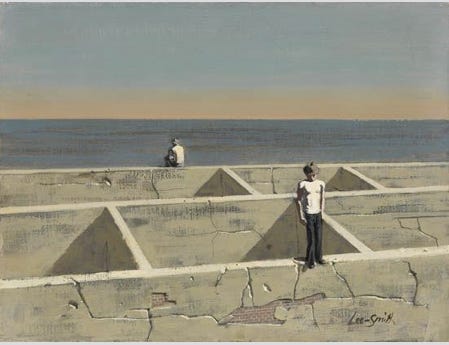The deal with liminal spaces
Lately I’ve been doing a lot of driving and it’s been a complete game changer for me mentally. I love the way it feels to be behind a steering wheel; that low rumbling of potential risk in my chest. The solitude. That time spent alone in the car is when I feel the most independent - the most myself. I can get from point A to point B on my own terms. Well, recently I was driving a decent distance and had a strange 3rd person moment. I wasn’t as extreme as an out of body experience, but I became hyper aware of where I was, yet I felt very detached, which began to feel very liminal. I questioned whether car rides could be considered liminal spaces, which of course, opened a can of worms.
Liminality
When I think of a liminal space, I think of an empty, cavernous interior, much like an empty hallway, parking garage, or a train station bathroom after midnight. They’re characterized as transitions from one place to the next, either physically or metaphorically. Beyond their physicality, they’re also uncomfortable places to be, likely due to that “almost there” feeling. Without being tangibly connected to one end or the other, it’s easy to be overwhelmed by the lack of control over what comes next and when that next comes.
I also never really thought of liminal spaces as being nostalgic, but I guess there can also be a sense of familiar discomfort there, made very clear by this TikTok titled 2008 Birthday Party. When I watched the video for the first time, I was immediately brought back to my own birthdays 10+ years earlier, surrounded by that same glow in the dark carpeting. It’s interesting how an environment super nostalgic to me at 28, was titled ‘2008’ and uploaded to something even more contemporary like TikTok. If liminal spaces are in fact characterized as nostalgic, it’s clear they have the power to transcend generations and tap into whatever part of the brain controls our recognition (the temporal lobe, according to Google). I think that’s why they make most people feel so uneasy; that “I’ve been here" feeling that has no tangibility and maybe more than one reason for being recognized. Memory is a strange thing. It links us all, even in experiences we haven’t shared.
For instance, we’re all familiar with the new-found liminal nature of malls. This article for The New Yorker said it best, “[liminal spaces] owe much of their appeal to their framing and lack of human presence, which obliterate context and invite the viewer to populate the image with our own memories of comparable scenes.” With how familiar malls are to us, we can easily place ourselves in them. Malls have quickly become these large time capsules filled with both memories we’ve experienced personally and the memory of witnessing another’s experience - like on screen.
Mean Girls, 2004
Clueless, 1995
Not to mention the endless list of holiday shopping scenes, and shows like Stranger Things that brought us back to the mall’s 80’s prime. But now that the mall has fallen from its original state of grace, they exist as familiar ghost towns, with sprinkles of memory roaming in and out of old Hot Topics and Aéropostales.
More than just a space
Looking to art briefly, both surrealist and sometimes realist art movements depict dreamlike settings where it’s unclear what’s referencing reality or a dream. To start, this particularly liminal work by surrealist painter René Magritte titled Time Transfixed offers up a dose of nostalgia with the uncertainty of where that train is going. (Really though, this image always tripped me out. I genuinely think this is where J.K. R*wling got her idea for Platform 9 3/4. But screw her so whatever).

Or this Hughie Lee-Smith below from 1968. Often associated with both realist and surrealist movements, his work isn’t always liminal, but this one captured a particular solitude with both subjects stranded between the concrete structure and whatever lies ahead.

In similar American realist fashion, Edward Hopper (famous for Nighthawks) depicted his secluded studio as an empty, sunlit space overlooking Cape Cod. He titled it Rooms by the Sea but described it in his notebook as “The Jumping Off Place.”
Fitting!

So, is there something about these liminal spaces that can be therapeutic, despite their liminality? With that sense of detachment from the tangible being considered tranquil, or meditative. Is it possible for them to also make us feel good, maybe even alive? So I guess that’s the deal with liminal spaces; their liminality has a depth that taps into our fears, joy, and even our memories. And I think that’s pretty wild.
As always, thanks for reading
Elizabeth




